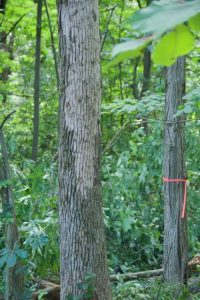Kiss Your Ash Trees Goodby

Wisconsin’s woodlands are changing. Emerald Ash Borer (EAB) is causing the greatest die-off of trees in the state since Dutch elm disease arrived in the 1960s. If you have ash trees on your property, you must learn to recognize EAB damage and quickly take action. In Wisconsin, that means black, green or white ash. Time is not your friend; indecision will remove any options. The Wisconsin Department of Agriculture, Trade and Consumer Protection (DATCP) has a website that shows where EAB is prevalent.
First, cruise your timber. Early detection is your best and only defense. Check out the Wisconsin DNR for website for woodlot owners. Treatment must be made to individual trees and completed before 1/3 if the crown is lost.

Symptoms
One of the best ways to identify emerald ash borer damage is through the “D” shaped holes emerging insects leave in the bark. Unfortunately, these holes are approximately 3/16 inch in diameter and may first appear rather high in the tree. The cream colored larvae living under the bark can be 1½ inches long. These are exit holes for the larvae that are emerging to morph into adults.
Most landowners will first spot the infestation by observing leaf loss in the crown. This crown thinning can easily be overlooked or written off as storm damage. By the time the damage is obvious, it is probably too late.

Bark blonding takes place when the bark of an infested tree shards to shed the outer layer of its bark. The tree is essentially dead at this point. Blonding occurs because the sapwood below the bark is dead and outer layers of bark are drying out and stuffing off.

The EAB lays it eggs under the bark. When the eggs hatch, they spend two years developing in the cambium layer of the ash tree. They eat the sapwood, burrowing tunnels are they feed. The tunnels interrupt nutrient flow. Eventually, limbs and even the trunk die as tunnels completely cut the supply of sugars and water.
What’s Next?
If tree you want to save is less than 47″ around at chest height, you may be able to treat it yourself. You can apply a liquid soil drench homeowner product for about $20-35/year. An arborist should treat larger trees or those with special circumstances. Their treatments involve directly injecting trees under the bark. Those treatments typically cost several hundred dollars and must be repeated every 2-3 years.
Recent research suggests that EAB density moves through a forest like a wave (Sadof, 2017). Chemical treatment is most effective when begun early and should be continued for approximately ten years after initial infestation. At that point most neighboring trees have already died and the great mass of EAB have moved on to greener pastures (forests).
The cost or removing dead ash trees start at $1,000 and more, depending on size and location. Your only choice, if you have too many trees to treat, may be to conduct a timber harvest.
More Informaiton
The Emerald Ash Borer Information Network has the latest information about he pest and how to control it.
References
Sadof, Clifford S., Hughes, Gabriel P., Witte, Adam R., Peterson, Donnie J., and Ginzel, Matthew D. Tools for Staging and Managing Emerald Ash Borer in the Urban Forest, Arborculture & Urban Forestry, 43(1): 15-26. 2017.

[…] to help landowners identify tree pests. I have a file folder full of publications pests like emerald ash borer. If you are like me, I see something that does not look quite right and want to know what’s […]